Under the Reign of a New More Naturalistic Style of Egyptian Art Developed
Understanding Egyptian fine art lies in appreciating what it was created for. Aboriginal Egyptian art must be viewed from the standpoint of the ancient Egyptians non from our viewpoint. Here we explore the basis of Egyptian art.
Defining Style
Understanding Egyptian art lies in appreciating what it was created for. Ancient Egyptian fine art must be seen from the viewpoint of the ancient Egyptians, non from ours.
The somewhat static, formal, abstruse, and ofttimes blocky nature of much of Egyptian imagery has led to it existence compared unfavourably with more 'naturalistic,' Greek or Renaissance fine art. But the art of the Egyptians served a unlike purpose than that of these later cultures.
Another problem is 'What practise we mean by Style?'
- Was the Egyptian 'manner' different from today's view of 'style'?
Fashion is defined as 'how you do something.' Fashion should be distinctive and recognisable. It is derived from the Latin stylus,meaning writing implement, and was first concerned with the different writing of individuals. In art in that location are two aspects to manner and sometimes one style dominates. In Egyptian art that is the case.
The first aspect is the individual fashion of the artist. This can be difficult to determine with some cultures, and is mostly indicated past the methods used to produce the art. This expanse of fashion tin be divided into assertive way which is personal to the artist and carries information supporting individual identity and then at that place is emblemic style which carries data about the group identity of the society the artist belongs to.
The second aspect of way is concerned with stylistic culture and is actually a way of communicating or tranfering data. Egyptian art is dominated by this stylistic aspect.
What is striking about Egyptian art is that text accompanied almost all images. In statues the identifying text volition appear on a back pillar supporting the statue or on the base of operations. Relief or paintings usually accept captions or longer texts that elaborate and complete the story in the scenes. Paintings and panels are frequently accompanied past hieroglyphs. Hieroglyphs are often works of art in themselves, fifty-fifty though many are instead phonetic sounds. Some stand for an object or concept which we phone call logographic which is a graphic that represents a give-and-take (Effigy 1). Today the mod symbols used on road signs would be logograms.
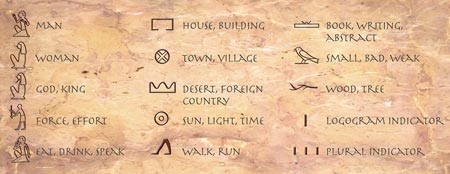
Effigy ane: Egyptian logograms. Peter Bull.
When looking at a piece of Egyptian art the text and prototype are not e'er clearly defined for example the formative (a sign at the end of a word that indicates identification of motility is adamant by a pair of legs and the proper name of a human being is shown by the image of a man).
The exception to this Egyptian style is the art from the menses of Akhenaten (1352 – 1336 BCE). He rejected the pantheon of gods in favour of one god and forth with that radical motility the art from this reign was different.
The proportions of the homo form are seen in farthermost with large heads and drooping features, narrow shoulders and waist, small torso, large buttocks, drooping belly and brusk artillery and legs. We do non know why there was such a radical change, and after his reign the art reverted to classical forms (Figure 2).
a)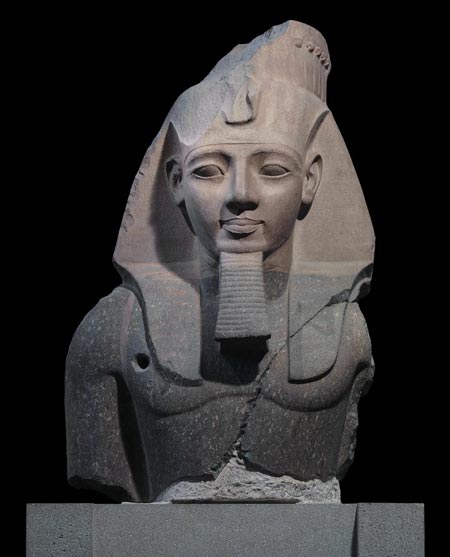 b)
b)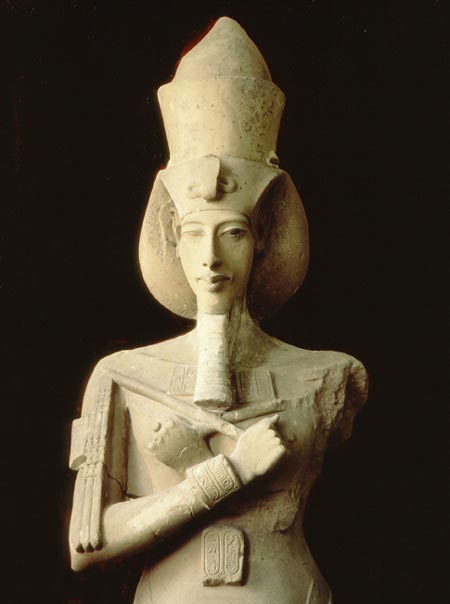
Figure 2: a) Rameses II compared with b) Akhenaten, note the differences. a) © The Trustees of the British Museum, b) © The Art Archive / Alamy
Egyptian Manner in Statues
While today nosotros marvel at the glittering treasures from the tomb of Tutankhamen, the beautiful reliefs in the New Kingdom tombs, and the serene beauty of Sometime Kingdom statues, information technology is important to think that the bulk of these works were never intended to be seen, that was not their purpose. So when nosotros look at them for fashion we can know the person by interpreting the accompanying hieroglyphs, but the fashion of decoration is likewise singled-out and tells u.s.a. something nearly the guild.
- What was distinct about the mode of the Egyptian art?
- Tin can we place the conventions and, if so, what are they?
These images of high-status people, whether statues of gods or pharaohs or reliefs on tomb walls, were designed to benefit a divine or deceased recipient. The bulk of Egyptian art exhibits frontality. This merely means they face up straight ahead with just one eye visible and both shoulders forepart facing and this tin make them expect rigid (Figure 3).
- Were at that place other conventions of style in Egyptian art?

Figure 3: Egyptian Book of the Expressionless showing the stylistic features. © The Trustees of the British Museum.
The primary conventions of Egyptian fine art can be seen in Effigy 3 above. Stylistic conventions adopted by every artist in ancient Egypt included not but 'Frontality' simply besides 'Axiality'. The rules of axiality meant figures were placed on an axis.
Proportions of figures were related to the width of the palm of the paw so in that location were rules most proportions of head to body. The faces did not express emotions.
The sizes of figures were determined past their importance. The proportions of children did not change; they are merely depicted smaller in calibration. Servants and animals were usually shown in smaller scale. In society to clearly define the social bureaucracy of a situation, figures were drawn to sizes based not on their distance from the painter'south point of view simply on relative importance. For case, the Pharaoh would be drawn every bit the largest figure in a painting no matter where he was situated, and a greater God would exist fatigued larger than a lesser god.
Axiality, proportion and hieratic scaling point that Egyptian artists would have had to utilise mathematics to construct their composition. Aboriginal Egyptian artists used vertical and horizontal reference lines in club to maintain the correct proportions in their work. In many tombs the walls still carry these grids used to ensure the conventions were kept to by the lower and apprentice artists working for the main creative person. Political and religious, as well as artistic order was maintained in Egyptian art.
Important figures were non usually depicted overlapping, but figures of servants were. Each object or chemical element in a scene was designed and drawn from its most recognizable angle. The objects in a scene were then grouped together to create the whole. This is why images of people show their face, waist, and limbs in profile, but the eye and shoulders are shown facing frontally. These scenes are composite images designed to provide complete information well-nigh the human relationship of the objects to each other, rather than from a single viewpoint.
Rules were also applied to the poses and gestures of the figures to reflect the meaning of what the person was doing. An aboriginal Egyptian creative person would depict a figure in an act of worship with both arms extended frontwards with hands upraised.
They did not attempt to replicate the real world but did achieve a realistic dialogue between the three dimension world and their paintings past the apply of position and grouping to represent depth so the groundwork is shown above the figure the foreground below or to one side.
Nearly formal statues prove a prescribed frontality, meaning they are arranged to await straight alee, considering they were designed to confront the ritual being performed before them.
Frequently this is in a temple or tomb such as the row of four jumbo statues of Rameses II outside the main temple at Abu Simbel (Figure four). They were designed to face the rising dominicus then important in Egyptian religion.
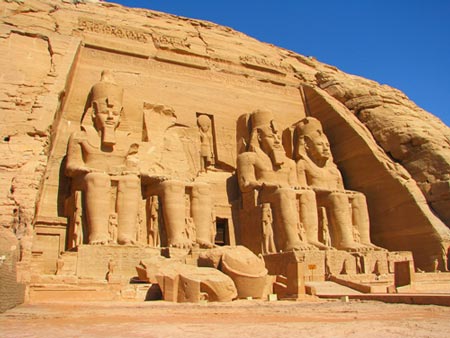
Figure 4: Statues of Rameses II at Abel Simbel. © Shutterstock.
Statues were set up up to take part in the rituals relating to the gods and the pharaoh. Many statues were besides originally placed in recessed niches or other architectural settings; contexts that would make frontality their expected and natural mode. Others were placed confronting pylons or along an avenue to the temple as in Figure 5.
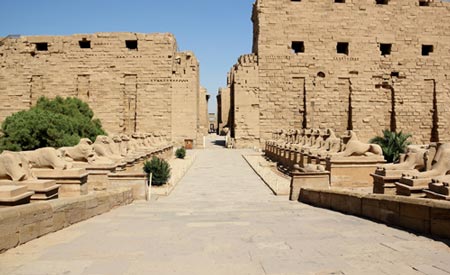
Figure five: Artery of Sphinxes and first pylon at western entrance to Precinct of Amun Re Karnak Temple. © Shutterstock
Statuary, whether divine, imperial, or elite, provided a conduit for the spirit (or ka) of the represented being to interact with the earthly realm. Divine cult statues (few of which survive) were the discipline of daily rituals. Those rituals would include those of clothing, anointing, and perfuming with incense the statue. Sometimes they came out of the temple and were carried in processions for special festivals, so that the people could "see" them even though they were nigh all entirely shrouded from view in wooden arks, but their 'presence' was felt.
The reason for this frontality is they were designed not as an art form but as part of a religious ritual. The Egyptians did not have a discussion for art but they had words for statue, stelae or tomb. They had a sense of the aesthetic but within a function. Art is then functional within the religion.
Forest and metal bronze to represent generic figures and these in contrast to the ritual statues were more than expressive. The arms could be extended and hold separate objects, spaces between the limbs were opened to create a realistic appearance, and more positions were possible. Fifty-fifty then the art conventions were kept to (Figure six).
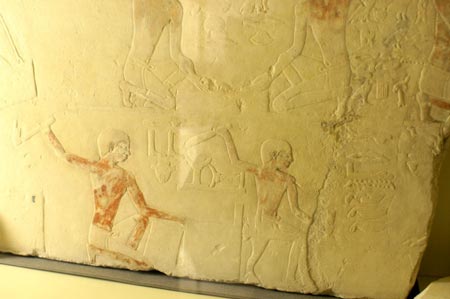
Figure vi: Relief of craftmen. Pat O'Brien
Rock, wood, and metallic statuary of aristocracy figures all served the same functions and retained the same blazon of formalization and frontality. Only statuettes of lower condition people displayed a wide range of possible deportment, and these pieces were focused on the deportment, which benefitted the aristocracy owner, not the people involved.
Hence these generic figures were frequently put in tombs to serve the tomb owners in the afterlife as bakers, scribes and other occupations. They were at that place equally shabti probably developed from the servant figures mutual in tombs of the Middle Kingdom. They were shown every bit mummified like the deceased, with their own coffin, and inscribed with a spell to provide food for their master or mistress in the afterlife. Alternatively there tin be models of the servants both sorts can be seen in Effigy 7, below.
a) b)
b)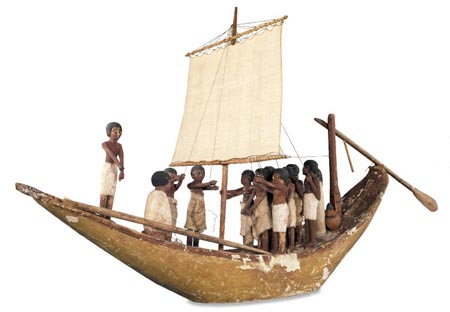
Effigy seven: a) Shabti figures; b) model of a sailing ship. © The Trustees of the British Museum.
Small figures of deities, or their beast personifications, are very common, and found in popular materials such as pottery. In that location were also large numbers of small carved objects, from figures of the gods to toys and carved utensils. Alabaster was often used for expensive versions of these; painted woods was the most common material, and normal for the small models of animals, slaves and possessions placed in tombs to provide for the afterlife.
Three-dimensional representations, while being quite formal, too aimed to reproduce the real-world—statuary of gods, royalty, and the elite was designed to convey an idealized version of that private. Some aspects of 'naturalism' were dictated by the material. Stone statuary, for case, was quite closed—with arms held shut to the sides, limited positions, a strong back colonnade that provided support, and with the fill spaces left between limbs
Egypt Style in Paintings and Relief
Paintings demonstrated two-dimensional art and as a result it represented the globe quite differently. Egyptian artists used the two-dimensional surface to provide the virtually representative aspects of each object in the scene.
- Does the painted fine art besides prove the same conventions?
Egyptian artists worked in 2 dimensions simply then the best characterisation of the object was the view the artist used. Again they used the ideas of frontality, axiality and proportionality. Then when creating the human class the artist showed the head in profile with full view heart line parallel with the shoulder line while the chest, waist, hips and limbs are in profile. However, if in that location is neck jewellery to exist shown it is shown in full (Figure 8).
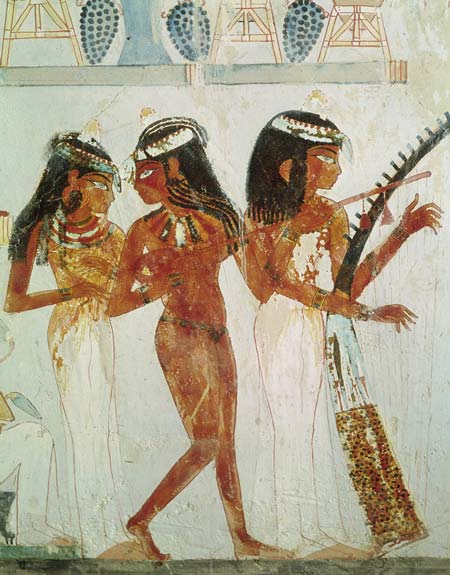
Figure 8: Musicians, Tomb of Nakht. © The Art Gallery Collection / Alamy.
Scenes were ordered in parallel lines, known as registers. These registers carve up the scene besides every bit provide ground lines for the figures. Scenes without registers are unusual and were more often than not only used to specifically evoke chaos; battle and hunting scenes will often show the casualty or foreign armies without ground lines. Registers were also used to convey information about the scenes—the higher up in the scene, the higher the status; overlapping figures imply that the ones underneath are farther away, as are those elements that are college within the register.
Swell observation, exact representation of actual life and nature, and a strict conformity to a set of rules regarding representation of three dimensional forms dominated the character and style of the fine art of ancient Egypt. Completeness and exactness were preferred to prettiness and cosmetic representation. The use of mathematics to create the art is also very evident in many of the incomplete fine art forms indicating that Egyptian artists used some mathematical formulas to create order in their art.
Considering of the highly religious nature of Ancient Egyptian civilization, many of the great works of Ancient Arab republic of egypt draw gods, goddesses, and Pharaohs, who were also considered divine. Ancient Egyptian art is characterized by the idea of order. Clear and unproblematic lines combined with elementary shapes and flat areas of colour helped to create a sense of gild and balance in the art of ancient Egypt.
Symbolism played an important office in establishing a sense of order this ranged from the pharaoh's regalia (symbolizing power to maintain order) to the individual symbols of Egyptian gods and goddesses. Animals were besides highly symbolic figures in Egyptian fine art.
Colours of the subjects were more expressive rather than natural. So a cherry-red skin implied hard working tanned youth, whereas yellow skin was used for women or middle-aged men who worked indoors. The presence of blue or gold indicated divinity. The utilize of black for regal figures expressed the fertility of the Nile. Stereotypes of people were employed to indicate geographical origins.
Difference in scale was unremarkably used for conveying hierarchy. The larger the calibration of the figures, the more important they were. Kings were oft shown at the aforementioned scale every bit the deities, and both are shown larger than the aristocracy and far larger than the full general populace and in smallest scale are shown servants, entertainers, animals, trees, and architectural details. And then the size indicates relative importance in the social gild.
Aboriginal Egyptian art forms are characterized by regularity and detailed depiction of gods, human beings, heroic battles, and nature. A loftier proportion of the surviving works were designed and made to provide peace and assistance to the deceased in the afterlife. The artists' desire was to preserve everything from the present equally conspicuously and permanently as possible. Ancient Egyptian fine art was designed to stand for socioeconomic status and conventionalities systems.
The Egyptians used the distinctive technique of sunken relief, well suited to very bright sunlight. The main figures in reliefs adhere to the same figure convention as in painting.
Papyrus was used by ancient Egyptians and information technology was exported to many states in the ancient world for writing and painting. Papyrus is a relatively fragile medium by and large lasting around a century or ii in a library, and though used all over the classical world has merely survived when buried in very dry weather condition, and and so, when institute, is oftentimes in poor condition.
Source: https://edu.rsc.org/resources/principles-of-egyptian-art/1622.article
0 Response to "Under the Reign of a New More Naturalistic Style of Egyptian Art Developed"
Post a Comment